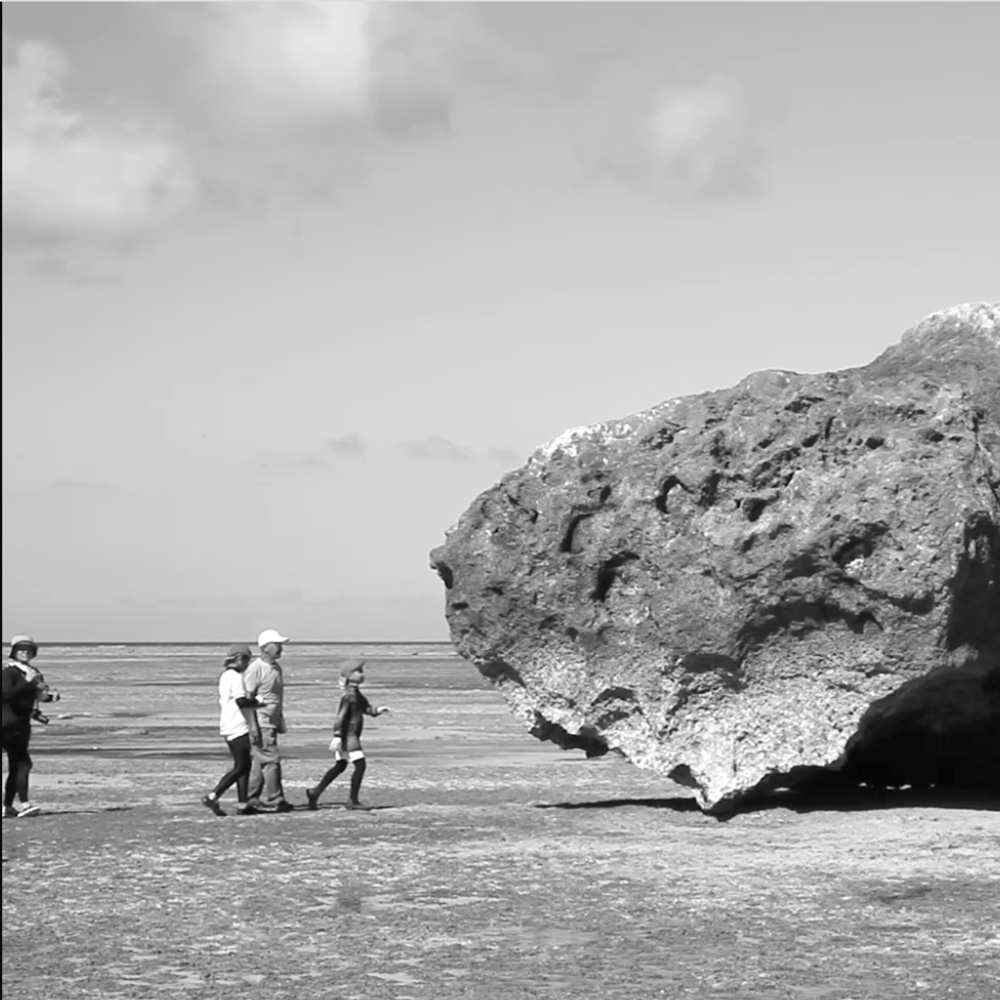「美しいと言うこと」の自由について
「美しい」ということについて、Mami、下道基行、そしてmamoruの作品を通して考えてみようと思う。なぜなら、私たちは最近アートを見ても「美しい」とは言わなくなっているから。
「美しい」の変わりに、最近よく使われるのは「興味深い」という言葉だ、と言ったのは、批評家のスーザン・ソンタグだった。彼女は「美について」というテキストで、「美」という価値がどうして「興味深い」にとってかわられたのか、とても「興味深い」考察を述べている。(1)
「美しい」という言葉は、規範化されている表面的な形式を指し示しているような印象を与えがちだ。その形式は絶対的で、厳格な価値を備えているようで窮屈な感じがするし、その規範から逸脱するユニークさは排除されてしまう印象がある。だから、この窮屈で保守的な「美しさ」からより自由で幅のある価値を求めて、「面白い」という言葉が使われるのだろう。「面白い」は、確かに便利な言葉だ。ある作品をどうにも受け入れ難いと思っても、とりあえず「面白い」と言っておけばその場のお茶を濁し、自分の価値判断に猶予を与えることができる。
さて、Mami、下道、mamoruはそれぞれ身体、写真、音と三者三様異なる素材を媒介にアーティスト活動を実践している。しかし、彼らに共通するのは、プロダクツとしてのアートを作るのではなく、人と人との関係や、普段見過ごしていたり気に留めない事象に対しての気づきなど、形を持たない瞬間を作り出していることだ。アートをモノづくりだと考えるならば、彼らの実践はそこからはずれたちょっと「面白い」ものだが、果たして本当に「面白い」という言葉で片付けてしまうことがふさわしいかは疑問だ。それは、彼らの実践の根底に「美しさ」の発見があると思うからだ。人と人のコミュニケーションの課程で生じる笑いや、日常生活の中でさりげなく、あぶくのように生まれる創造性、普段何気なく使っている日用品がかすかに奏でる音、こうした現象にこの3人の作家は愛おしさをもって眼差しを向け、実践を通してアートへと昇華させる。
私たちが目撃する彼らの実践は、人が生活している場所であれば、「今、ここ」でも、「どこでもない場所」でも、共有されうるささやかだが普遍的な「美しさ」への誘いである。そのインビテーションは、今や世界のどこにでも開催されているアートプロダクツが溢れる市場優先型のアート界とは、逆の方向を指している。だから、わたしは彼らの実践を見聞したときに勇気づけられ、こう感じることができるのだ。日常生活の中で、もっともっと「美しい」と言っても良いのだと。そして、アートは「美しい」という言葉を発することのためらいから、解放してくれるものなのだと。
高橋 瑞木(水戸芸術館現代美術センター学芸員)
(1)Susan Sontag, An Argument about Beauty, Daedalus, Vol. 131, 2002
※この文章は、Mami、mamoru、下道基行、3人展「NOWHERE」の為に書き下ろされた文章です。
:::::::::::::::::::::::::::::::
The Freedom to Say That “It Is Beautiful”
Mizuki Takahashi / curator, Contemporary Art Center, Art Tower Mito
I would like to consider the issue of stating “beauty” by examining the works of Mami, Motoyuki Shitamichi, and mamoru. It must be worth discussing about it because of the fact that people no longer respond to the art works saying that it is “beautiful” anymore. Suzan Sontag, a critique, once wrote that the people recently tend to employ the word “interesting” instead of “beauty.” In her essay, “An Argument about Beauty”(1), she raised an “interesting” discussion about how “beauty” as a word representing a sense of value has been replaced by “interesting.”
The word “beauty” tends to give such an impression that it is referring to a standardized form; the form nearly stands as something absolute, together with a set of value which is rigid and restrictive. The alternatives that deviate from it are most likely to be excluded. Therefore, people prefer to say “it is interesting,” hoping that it implies much broader and flexible senses of values rather than this binding and conservative “beauty”. The word “interesting” is surely convenient as an opinion on the work that you cannot appreciate or understand at a first glance. You can avoid making your clear standpoint and postpone your final judgment on it for a while.
Mami, Shitamichi, and mamoru practice and realize their art with different media: body, photography, and sound. However, instead of producing art objects, all of them create ephemeral moments that do not have any physical shape, such as relationship between people, and the awareness to the subtle gestures that we normally do not pay any attention to. Therefore if I define art as the fabrication of the objects, then their artistic practices are off the grid, and in this regard, their works are “interesting”. But I am reluctant to label them as just being “interesting” since I find the notion of “beauty” underneath their practices. They discover “beauty” in the humor that is brought into being through communication among people, in the everyday creativity that is indistinct and that may only last for a short while, and in the sound of the everyday objects that we use without any care. These three artists look into those elements with their affections and mold them into the art works.
They draw you into the understated yet fundamental “beauty.” Therefore their artistic practices that we would be witnessing can be understood whether it is “now here” or “nowhere”, any place where people run their lives around. They invite us towards the opposite direction of the current art world, which is market-driven, and full of commercial art productions. This is why I feel encouraged when I observe or learn about what these three artists are doing. I can feel free to say that “it is beautiful” in everyday basis, and feel also free to believe that art can break the chains of our hesitation and give us freedom to say that “it is beautiful.”
(1) Susan Sontag, An Argument About Beauty, Daedalus, Vol. 131, 2002
